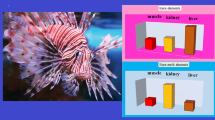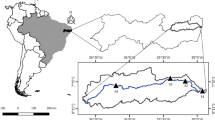Abstract
Metals (trace elements and rare earth elements, REEs) were analysed by inductively coupled plasma-mass spectrometry in blood, the liver, the kidney and muscle of ex situ spotted dogfish (Scyliorhinus stellaris). The controlled environment in which these elasmobranchs were hosted allowed to assess a baseline level of metals in the different organs since exposure via water and food can be easily monitored. The highest arsenic, chromium, copper, and iron values were found in the liver, cobalt in the kidney, and cadmium and rubidium in muscle. The highest total trace elements content was found in the trend liver (75 mg kg−1) > blood (33 mg kg−1) > muscle (31 mg kg−1) > kidney (10 mg kg−1), while the ΣREEs was the liver (30 μg kg−1) > muscle (15 μg kg−1) > kidney (13 μg kg−1) > blood (4.1 μg kg−1). Between REEs, the most represented element was scandium. Significant differences in the concentration of metals among organs were observed for almost all elements. Nonessential elements were generally lower and essential elements higher in the examined specimens compared to wild elasmobranchs, suggesting a close relationship between a balanced diet and animal welfare.



Similar content being viewed by others
Data availability
Data supporting the findings are available from the corresponding author upon reasonable request.
References
Bashir FA, Alhemmali AM (2015) Analysis of some heavy metal in marine fish in muscle, liver and gill tissue in two marine fish spices from Kapar coastal waters, Malaysia. The Second Symposium on Theories and Applications of Basic and Biosciences 2(1):1–15
Coelho JP, Santosa H, Reisa AT, Falcão J, Rodrigues ET, Pereira ME, Duarte AC, Pardal MA (2010) Mercury bioaccumulation in the spotted dogfish (Scyliorhinus canicula) from the Atlantic Ocean. Mar Pollut Bull 60:1372–1375
De Boeck G, Eyckmans M, Lardon I, Bobbaers R, Sinha AK, Blust R (2010) Metal accumulation and metallothionein induction in the spotted dogfish Scyliorhinus canicula. Comp Biochem Physiol A Mol Integr Physiol 155:503–508
Directive 2002/32/EC of the European parliament and of the council of 7 May 2002 on undesirable substances in animal feed. Official Journal of the European Communities. L 140/10
Dulvy NK, Simpfendorfer CA, Davidson LNK, Fordham SV, Bräutigam A, Sant G, Welch DJ (2017) Challenges and priorities in shark and ray conservation. Curr Biol 27(11):R565–R572
Fattorini D, Notti A, Regoli F (2006) Characterization of arsenic content in marine organisms from temperate, tropical, and polar environments. Chem Ecol 22(5):405–414
Hayes CT (2019) Reference module in earth systems and environmental sciences. Encyclopedia of Ocean Sciences (Third Edition) Volume 1,2019, pp 198–207
IUCN (2021) The IUCN Red List of Threatened Species. Version 2021–2. Available at: www.iucnredlist.org. (Accessed: 04 September 2021)
Li J, Zheng L, Sun C, Jiang F, Yin X, Chen J, Han B, Wang X (2016) Study on ecological and chemical properties of rare earth elements in tropical marine organisms. Chin J Anal Chem 44(10):1539–1546
MacMillan GA, Chételat J, Heath J, Mickpegak R, Amyot M (2017) Rare earth elements (REE) in freshwater, marine, and terrestrial ecosystems in the eastern Canadian Arctic. Environ Sci Process Impacts 19(10):1336–1345
Mansilla-Rivera I, Rodríguez-Sierra CJ (2011) Metal levels in fish captured in Puerto Rico and estimation of risk from fish consumption. Arch Environ Contam Toxicol 60:132
Marques AFS, Alves LMF, Moutinho A, Lemos MFL, Novais SC (2021) Scyliorhinus canicula (Linnaeus, 1758) metal accumulation: a public health concern for Atlantic fish consumers? Mar Pollut Bull 169:112477
Merly L, Lange L, Meÿer M, Hewitt AM, Koen P, Fischer C, Muller J, Schilack V, Wentzel M, Hammerschlag N (2019) Blood plasma levels of heavy metals and trace elements in white sharks (Carcharodon carcharias) and potential health consequences. Mar Pollut Bull 142:85–92
Mille T, Cresson P, Chouvelon T, Bustamante P, Brach-Papa C, Sandrine B, Rozuel E, Bouchoucha M (2018) Trace metal concentrations in the muscle of seven marine species: comparison between the Gulf of lions (north-West Mediterranean Sea) and the Bay of Biscay (north-East Atlantic Ocean). Mar Pollut Bull 135(May):9–16
Squadrone S, Brizio P, Stella C, Prearo M, Pastorino P, Serracca L, Ercolini C, Abete MC (2016a) Presence of trace metals in aquaculture marine ecosystems of the northwestern Mediterranean Sea (Italy). Environ Pollut 215(77–83):14
Squadrone S, Burioli E, Monaco G, KoyaMK PM, Gennero S, Dominici A, Abete MC (2016b) Human exposure to metals due to consumption of fish from an artificial lake basin close to an active mining area in Katanga (D.R. Congo). Sci Total Environ 568:679–684
Squadrone S, Brizio P, Battuello M, Nurra N, Mussat Sartor R, Benedetto A, Pessani D, Abete MC (2017) A first report of rare earth elements in northwestern Mediterranean seaweeds. Mar Pollut Bull 122(236):242
Squadrone S, Brizio P, Stella C, Mantia M, Battuello M, Nurra N, Mussat Sartor R, Orusa R, Robetto S, Brusa F, Mogliotti P, Garrone A, Abete MC (2019) Rare earth elements in marine and terrestrial matrices of Northwestern Italy: implications for food safety and human health. Sci Total Environ 660:1383–1391
Storelli MM, Busco VP, Marcotrigiano GO (2005) Mercury and arsenic speciation in the muscle tissue of Scyliorhinus canicula from the Mediterranean Sea. Bull Environ Contam Toxicol 75(1):81–88
Türkmen M, Türkmen A, Tepe Y, Tore Y, Ates A (2009) Determination of metals in fish species from Aegean and Mediterranean seas. Food Chem 113(1):233–237
Wei Y, Zhang J, Zhang D, Tu T, Luo L (2014) Metal concentrations in various fish organs of different fish species from Poyang Lake, China. Ecotoxicol Environ Saf 104:182–188. https://doi.org/10.1016/j.ecoenv.2014.03.001
Yang LP, Wang XN, Nie HQ, Shao LJ, Wang GL, Liu YJ (2016) Residual levels of rare earth elements in freshwater and marine fish and their health risk assessment from Shandong, China. Mar Pollut Bull 107(1):393–397
Vas P (1991) Trace metal levels in sharks from British and Atlantic waters. Mar Pollut Bull 22(2):67–72
Wang XN, Gu YG, Wang ZH (2021) Rare earth elements in different trophic level marine wild fish species. Environ Pollut 10:1016
Funding
This research was funded by the Italian Health Ministry Research Grants (Project n. IZS PLV 01/15RC).
Author information
Authors and Affiliations
Contributions
All authors contributed to the study. Activity planning, material preparation, clinical examination and data collection were in charge of Barbara Biancani. Husbandry of animals was in charge of Cristiano Da Rugna. Sabina Pederiva performed methodology optimization and chemical analysis. Stefania Squadrone wrote the first draft of the manuscript. All authors discussed the results and contributed to the final manuscript. Review and editing of the final manuscript were performed by Stefania Squadrone, Barbara Biancani, Cristiano Da Rugna, and Livio Favaro. Supervision was performed by Maria Cesarina Abete. All authors read and approved the final manuscript.
Corresponding author
Ethics declarations
Ethics approval
Not applicable
Consent for participation
Not applicable.
Consent for publication
Not applicable.
Conflict of interest
The authors declare no competing interests.
Additional information
Responsible Editor: Philippe Garrigues
Publisher's note
Springer Nature remains neutral with regard to jurisdictional claims in published maps and institutional affiliations.
Supplementary Information
Below is the link to the electronic supplementary material.
Rights and permissions
About this article
Cite this article
Squadrone, S., Biancani, B., Da Rugna, C. et al. Trace and rare earth element bioaccumulation in the spotted dogfish (Scyliorhinus stellaris). Environ Sci Pollut Res 29, 70262–70268 (2022). https://doi.org/10.1007/s11356-022-20886-8
Received:
Accepted:
Published:
Issue Date:
DOI: https://doi.org/10.1007/s11356-022-20886-8




